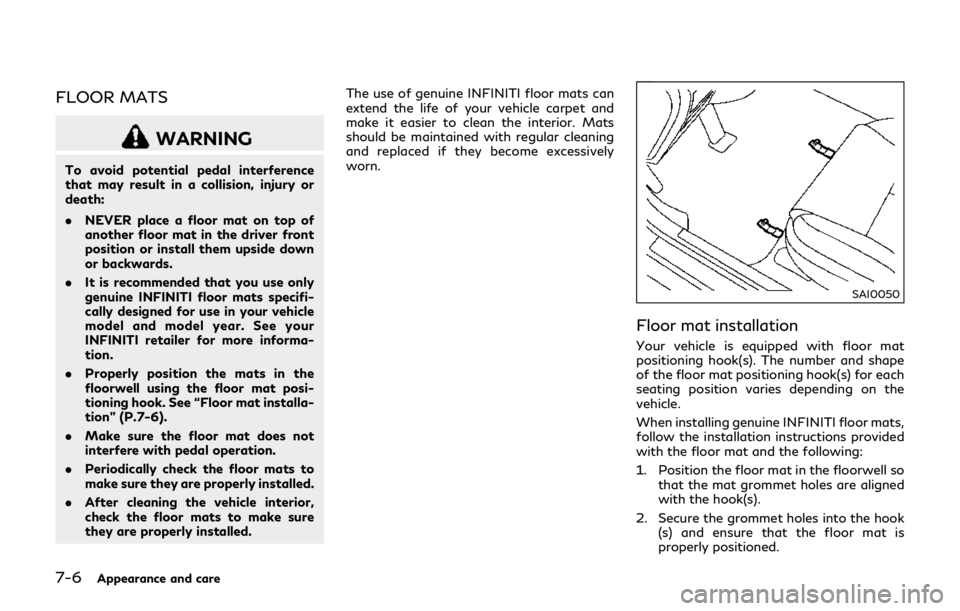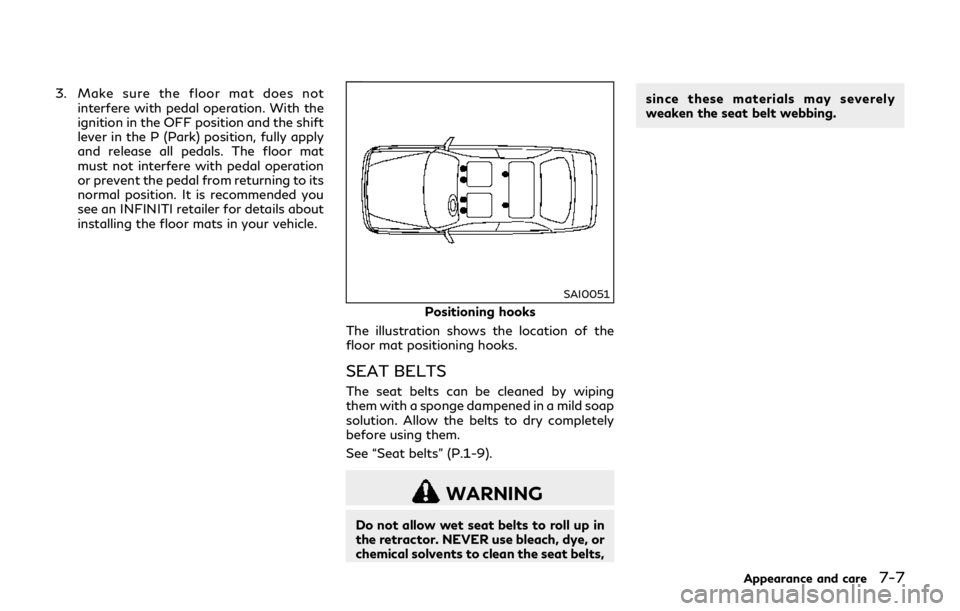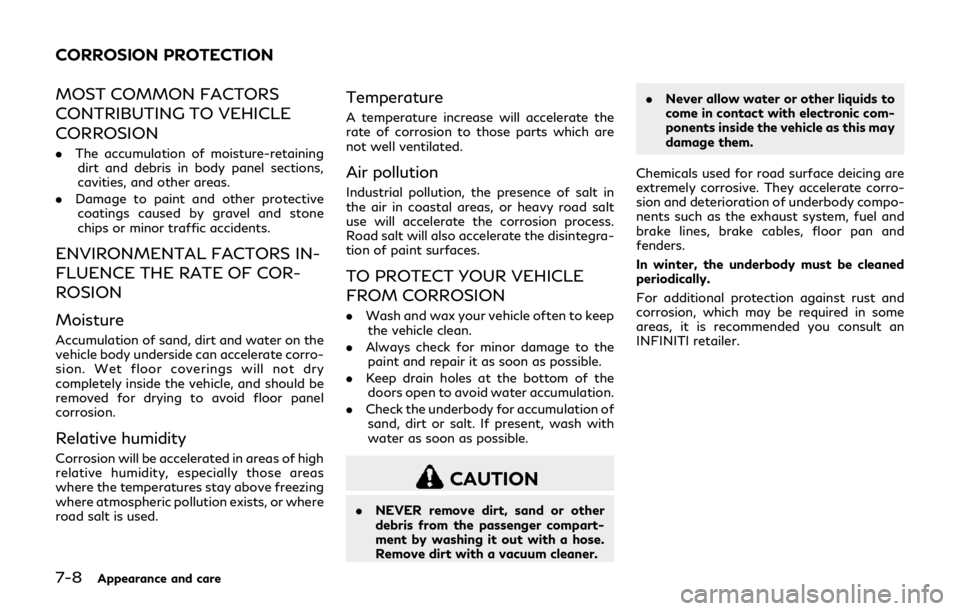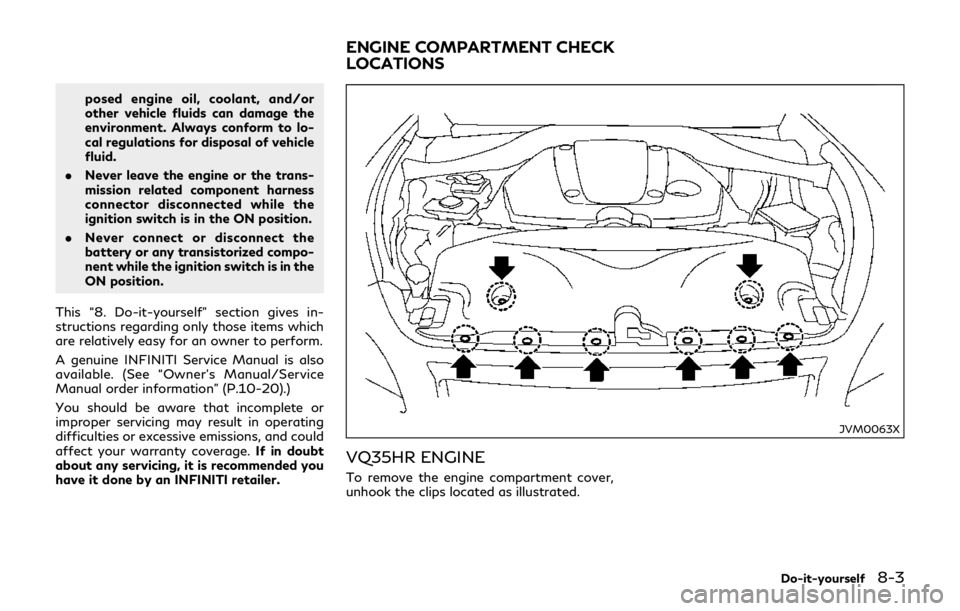INFINITI Q70 HYBRID 2018 Owner's Manual
Manufacturer: INFINITI, Model Year: 2018, Model line: Q70 HYBRID, Model: INFINITI Q70 HYBRID 2018Pages: 458, PDF Size: 2.23 MB
Page 371 of 458

7-6Appearance and care
FLOOR MATS
WARNING
To avoid potential pedal interference
that may result in a collision, injury or
death:
.NEVER place a floor mat on top of
another floor mat in the driver front
position or install them upside down
or backwards.
. It is recommended that you use only
genuine INFINITI floor mats specifi-
cally designed for use in your vehicle
model and model year. See your
INFINITI retailer for more informa-
tion.
. Properly position the mats in the
floorwell using the floor mat posi-
tioning hook. See “Floor mat installa-
tion” (P.7-6).
. Make sure the floor mat does not
interfere with pedal operation.
. Periodically check the floor mats to
make sure they are properly installed.
. After cleaning the vehicle interior,
check the floor mats to make sure
they are properly installed. The use of genuine INFINITI floor mats can
extend the life of your vehicle carpet and
make it easier to clean the interior. Mats
should be maintained with regular cleaning
and replaced if they become excessively
worn.
SAI0050
Floor mat installation
Your vehicle is equipped with floor mat
positioning hook(s). The number and shape
of the floor mat positioning hook(s) for each
seating position varies depending on the
vehicle.
When installing genuine INFINITI floor mats,
follow the installation instructions provided
with the floor mat and the following:
1. Position the floor mat in the floorwell so
that the mat grommet holes are aligned
with the hook(s).
2. Secure the grommet holes into the hook (s) and ensure that the floor mat is
properly positioned.
Page 372 of 458

3. Make sure the floor mat does notinterfere with pedal operation. With the
ignition in the OFF position and the shift
lever in the P (Park) position, fully apply
and release all pedals. The floor mat
must not interfere with pedal operation
or prevent the pedal from returning to its
normal position. It is recommended you
see an INFINITI retailer for details about
installing the floor mats in your vehicle.
SAI0051
Positioning hooks
The illustration shows the location of the
floor mat positioning hooks.
SEAT BELTS
The seat belts can be cleaned by wiping
them with a sponge dampened in a mild soap
solution. Allow the belts to dry completely
before using them.
See “Seat belts” (P.1-9).
WARNING
Do not allow wet seat belts to roll up in
the retractor. NEVER use bleach, dye, or
chemical solvents to clean the seat belts, since these materials may severely
weaken the seat belt webbing.
Appearance and care7-7
Page 373 of 458

7-8Appearance and care
MOST COMMON FACTORS
CONTRIBUTING TO VEHICLE
CORROSION
.The accumulation of moisture-retaining
dirt and debris in body panel sections,
cavities, and other areas.
. Damage to paint and other protective
coatings caused by gravel and stone
chips or minor traffic accidents.
ENVIRONMENTAL FACTORS IN-
FLUENCE THE RATE OF COR-
ROSION
Moisture
Accumulation of sand, dirt and water on the
vehicle body underside can accelerate corro-
sion. Wet floor coverings will not dry
completely inside the vehicle, and should be
removed for drying to avoid floor panel
corrosion.
Relative humidity
Corrosion will be accelerated in areas of high
relative humidity, especially those areas
where the temperatures stay above freezing
where atmospheric pollution exists, or where
road salt is used.
Temperature
A temperature increase will accelerate the
rate of corrosion to those parts which are
not well ventilated.
Air pollution
Industrial pollution, the presence of salt in
the air in coastal areas, or heavy road salt
use will accelerate the corrosion process.
Road salt will also accelerate the disintegra-
tion of paint surfaces.
TO PROTECT YOUR VEHICLE
FROM CORROSION
. Wash and wax your vehicle often to keep
the vehicle clean.
. Always check for minor damage to the
paint and repair it as soon as possible.
. Keep drain holes at the bottom of the
doors open to avoid water accumulation.
. Check the underbody for accumulation of
sand, dirt or salt. If present, wash with
water as soon as possible.
CAUTION
. NEVER remove dirt, sand or other
debris from the passenger compart-
ment by washing it out with a hose.
Remove dirt with a vacuum cleaner. .
Never allow water or other liquids to
come in contact with electronic com-
ponents inside the vehicle as this may
damage them.
Chemicals used for road surface deicing are
extremely corrosive. They accelerate corro-
sion and deterioration of underbody compo-
nents such as the exhaust system, fuel and
brake lines, brake cables, floor pan and
fenders.
In winter, the underbody must be cleaned
periodically.
For additional protection against rust and
corrosion, which may be required in some
areas, it is recommended you consult an
INFINITI retailer.
CORROSION PROTECTION
Page 374 of 458

8 Do-it-yourself
Maintenance precautions ................................................ 8-2
Engine compartment check locations .......................... 8-3VQ35HR engine............................................................ 8-3
Engine cooling system...................................................... 8-5 Checking engine coolant level................................... 8-6
Changing engine coolant............................................ 8-6
Inverter cooling system.................................................... 8-7 Checking inverter coolant level ................................ 8-8
Changing inverter coolant.......................................... 8-8
Engine oil.....................................................................\
......... 8-8
Checking engine oil level ............................................ 8-8
Changing engine oil and filter................................... 8-9
Automatic Transmission Fluid (ATF).......................... 8-11
Power steering fluid........................................................ 8-11
Brake fluid...................................................................\
....... 8-12 Brake fluid .................................................................... 8-12
Window washer fluid...................................................... 8-12
12-volt battery ................................................................. 8-13 Checking battery fluid level..................................... 8-14
Jump starting............................................................... 8-15
Spark plugs ........................................................................\
8-15 Replacing spark plugs................................................ 8-15 Air cleaner........................................................................\
.. 8-16
Windshield wiper blades ............................................... 8-17
Cleaning....................................................................... 8-17
Replacing..................................................................... 8-17
Brakes..................................................................\
............... 8-18 Self-adjusting brakes............................................... 8-18
Brake pad wear warning........................................ 8-18
Fuses...................................................................\
................ 8-19 Engine compartment or trunk room ................... 8-19
Passenger compartment ....................................... 8-20
Intelligent Key battery replacement........................... 8-21
Lights........................................................................\
.......... 8-23 Headlights.................................................................. 8-24
Exterior and interior lights.................................... 8-24
Wheels and tires.............................................................. 8-26 Tire pressure .............................................................. 8-26
Tire labeling............................................................... 8-30
Types of tires............................................................. 8-32
Tire chains................................................................... 8-32
Changing wheels and tires..................................... 8-33
Page 375 of 458

8-2Do-it-yourself
When performing any inspection or main-
tenance work on your vehicle, always take
care to prevent serious accidental injury to
yourself or damage to the vehicle. The
following are general precautions which
should be closely observed.
WARNING
.This vehicle has high voltage DC and
AC systems as well as a 12-volt
system. DC and AC high voltage is
very dangerous and can cause severe
burns and electric shock that may
result in serious injury or death.
. Never touch, disassemble, remove or
replace the high voltage parts, har-
nesses and their connectors. High
voltage cables are orange. Touching,
disassembling, removing or replacing
those parts and harnesses can cause
severe burns or electric shock that
may result in serious injury or death.
. Never try to remove the service plug
located in the trunk room. The service
plug is used only when the vehicle is
serviced by trained technicians wear-
ing personal protection equipment
and is part of the high voltage
system. Touching the service plug
can cause severe burns or electric shock that may result in serious injury
or death.
. The INFINITI Direct Response Hy-
brid
®System uses high voltage up to
408 volts. The system can be hot
while and after starting. Be careful of
both the high voltage and the high
temperature. Obey the caution labels
attached to the vehicle.
. Park the vehicle on a level surface,
apply the parking brake securely and
block the wheels to prevent the
vehicle from moving. Move the shift
lever to P (Park).
. Be sure the ignition switch is in the
OFF or LOCK position when per-
forming any parts replacement or
repairs.
. The engine can start at any time
without warning when the hybrid
system is in the READY to drive
mode. If you must work with the
Hybrid System in the READY to drive
mode, keep your hands, clothing, hair
and tools away from fans, belts and
any other parts that can move.
. It is advisable to secure or remove
any loose clothing and remove any
jewelry, such as rings, watches, etc.
before working on your vehicle. .
Always wear eye protection when-
ever you work on your vehicle.
. Your vehicle is equipped with an
automatic engine cooling fan. It may
come on at any time without warn-
ing, even if the ignition key is in the
OFF position and the engine is not
running. To avoid injury, always dis-
connect the negative battery cable
before working near the fan.
. If you must run the engine in an
enclosed space such as a garage, be
sure there is proper ventilation for
exhaust gases to escape.
. Never get under the vehicle while it is
supported only by a jack. If it is
necessary to work under the vehicle,
support it with safety stands.
. Keep smoking materials, flame and
sparks away from the fuel tank and
battery.
CAUTION
.Do not work under the hood while the
engine is hot. Turn the hybrid system
off and wait until it cools down.
. Avoid direct contact with used en-
gine oil and coolant. Improperly dis-
MAINTENANCE PRECAUTIONS
Page 376 of 458

posed engine oil, coolant, and/or
other vehicle fluids can damage the
environment. Always conform to lo-
cal regulations for disposal of vehicle
fluid.
. Never leave the engine or the trans-
mission related component harness
connector disconnected while the
ignition switch is in the ON position.
. Never connect or disconnect the
battery or any transistorized compo-
nent while the ignition switch is in the
ON position.
This “8. Do-it-yourself” section gives in-
structions regarding only those items which
are relatively easy for an owner to perform.
A genuine INFINITI Service Manual is also
available. (See “Owner’s Manual/Service
Manual order information” (P.10-20).)
You should be aware that incomplete or
improper servicing may result in operating
difficulties or excessive emissions, and could
affect your warranty coverage. If in doubt
about any servicing, it is recommended you
have it done by an INFINITI retailer.
JVM0063X
VQ35HR ENGINE
To remove the engine compartment cover,
unhook the clips located as illustrated.
Do-it-yourself8-3
ENGINE COMPARTMENT CHECK
LOCATIONS
Page 377 of 458

8-4Do-it-yourself
JVM0034X
1. Engine oil filler cap
2. Brake fluid reservoir
3. Fuse/fusible link holder
4. Window washer fluid reservoir
5. Power steering fluid reservoir
6. Inverter coolant reservoir
7. Air cleaner
8. Radiator filler cap
9. Engine oil dipstick
10. Engine coolant reservoir
Page 378 of 458

The engine cooling system is filled at the
factory with a pre-diluted mixture of 50%
Genuine NISSAN Long Life Antifreeze/
Coolant (blue) and 50% water to provide
year-round anti-freeze and coolant protec-
tion. The anti-freeze solution contains rust
and corrosion inhibitors. Additional engine
cooling system additives are not necessary.
WARNING
.Never remove the radiator or coolant
reservoir cap when the engine is hot.
Wait until the engine and radiator
cool down. Serious burns could be
caused by high pressure fluid escap-
ing from the radiator. See precau-
tions in “If your vehicle overheats”
(P.6-12).
. The radiator is equipped with a
pressure type radiator cap. To pre-
vent engine damage, use only a
genuine NISSAN radiator cap.
CAUTION
.Never use any cooling system addi-
tives such as radiator sealer. Addi-
tives may clog the cooling system and
cause damage to the engine, trans- mission and/or cooling system.
. When adding or replacing coolant, be
sure to use only Genuine NISSAN
Long Life Antifreeze/Coolant (blue)
or equivalent. Genuine NISSAN Long
Life Antifreeze/Coolant (blue) is pre-
diluted to provide antifreeze protec-
tion to −34°F (−37°C). If additional
freeze protection is needed due to
weather where you operate your
vehicle, add Genuine NISSAN Long
Life Antifreeze/Coolant (blue) con-
centrate following the directions on
the container. If an equivalent cool-
ant other than Genuine NISSAN Long
Life Antifreeze/Coolant (blue) is
used, follow the coolant manufac-
ture’s instructions to maintain mini-
mum antifreeze protection to −34°F
(−37°C). The use of other types of
coolant solutions other than Genuine
NISSAN Long Life Antifreeze/Cool-
ant (blue) or equivalent may damage
the engine cooling system.
. The life expectancy of the factory-fill
coolant is 105,000 miles (168,000
km) or 7 years. Mixing any other type
of coolant other than Genuine
NISSAN Long Life Antifreeze/Cool-
ant (blue) , including Genuine NISSAN
Long Life Antifreeze/Coolant
(green), or the use of nondistilled water will reduce the life expectancy
of the factory-fill coolant. Refer to
the “9. Maintenance and schedules”
section of this manual for more de-
tails.
Do-it-yourself8-5
ENGINE COOLING SYSTEM
Page 379 of 458

8-6Do-it-yourself
SDI2043
CHECKING ENGINE COOLANT
LEVEL
Check the coolant levelin the reservoir
when the engine is cold. If the coolant level
is below MIN
, open the reservoir tank cap
and add coolant up to the MAXlevel. If the
reservoir tank is empty, check the coolant
level in the radiator when the engine is cold.
If there is insufficient coolant in the radiator,
fill the radiator with coolant up to the filler
opening and also add it to the reservoir tank
up to the MAX level
.
Tighten the cap securely after adding engine
coolant. If the cooling system requires coolant fre-
quently, have it checked. It is recommended
you visit an INFINITI retailer for this
service.
CHANGING ENGINE COOLANT
It is recommended that major cooling system
repairs be performed by an INFINITI retailer.
The service procedures can be found in the
appropriate INFINITI Service Manual.
Improper servicing can result in reduced
heater performance and engine overheat-
ing.
WARNING
.
To avoid the danger of being scalded,
never change the coolant when the
engine is hot.
. Never remove the radiator cap when
the engine is hot. Serious burns could
be caused by high pressure fluid
escaping from the radiator.
. Avoid direct skin contact with used
coolant. If skin contact is made, wash
thoroughly with soap or hand cleaner
as soon as possible.
. Keep coolant out of reach of children
and pets. Engine coolant must be disposed of prop-
erly. Check your local regulations.
Page 380 of 458

The inverter cooling system is filled at the
factory with a pre-diluted mixture of 50%
Genuine NISSAN Long Life Antifreeze/
Coolant (blue) and 50% water to provide
year-round anti-freeze and coolant protec-
tion. The antifreeze solution contains rust
and corrosion inhibitors. Additional inverter
cooling system additives are not necessary.
WARNING
.Never remove the coolant reservoir
cap when the engine and inverter are
hot. Wait until the engine and in-
verter cool down. Serious burns could
be caused by high pressure fluid
escaping from the radiator.
. The inverter reservoir is equipped
with a pressure type cap. To prevent
engine and inverter damage, use only
a genuine NISSAN inverter reservoir
cap.
CAUTION
.When adding or replacing coolant, be
sure to use only Genuine NISSAN
Long Life Antifreeze/Coolant (blue)
or equivalent. Genuine NISSAN Long
Life Antifreeze/Coolant (blue) is pre- diluted to provide antifreeze protec-
tion to −34°F(−37°C). If additional
freeze protection is needed due to
weather where you operate your
vehicle, add Genuine NISSAN Long
Life Antifreeze/Coolant (blue) con-
centrate following the directions on
the container. If an equivalent cool-
ant other than Genuine NISSAN Long
Life Antifreeze/Coolant (blue) is
used, follow the coolant manufatur-
urer’s instructions to maintain mini-
mum antifreeze protection to −34°F
(−37°C). The use of other types of
coolant solutions other than Genuine
NISSAN Long Life Antifreeze/Cool-
ant (blue) or equivalent may damage
the inverter cooling system.
. The life expectancy of the factory-fill
coolant is 125,000 miles (200,000
km) or 15 years. Mixing any other
type of coolant other than Genuine
NISSAN Long Life Antifreeze/Cool-
ant (blue), including Genuine NISSAN
Long Life Antifreeze/Coolant
(green), or the use of non-distilled
water will reduce the life expectancy
of the factory-fill coolant. Refer to
the “9. Maintenance and schedules”
section of this manual for more de-
tails. .
Never use any additives in the cool-
ant such as radiator sealer in the
cooling system. This may cause da-
mage to electrical equipment such as
the motor and inverter, and also to
engine and transmission.
Do-it-yourself8-7
INVERTER COOLING SYSTEM